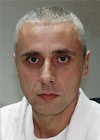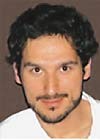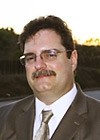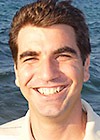
|
|
HOME / iCAT 2012 / INVITED LECTURES 2012
Invited lectures 2012
  | Dave Bourell University of Texas at Austin, USA The Evolution of Materials for Additive Manufacturing | Materials have always been critical to additive manufacturing (AM) technologies. Originally, materials selection for AM concentrated on the manufacturing properties and material availability in the requisite product form. As AM advanced, the focus has shifted towards part service properties. This was accelerated in the last ten years with the transition from prototyping to functional part applications. A hierarchy of materials for AM is proposed which includes single-phase materials, alloys and composites. Post-processing routes impact service properties as well. Factors giving rise to mechanical properties of AM parts will be reviewed including specific research currently underway in the Laboratory for Freeform Fabrication at The University of Texas at Austin. |
  | Ian Campbell Loughborough University, UK Artistic Engineering | In many parts of the world there are cultural, educational and economic divides between the worlds of artists and engineers. They are seen to have different aims, speak different languages and create different outcomes. However, the advent of additive manufacturing and related digital technologies has provided a route for these divides to be bridged. This paper presents a range of innovative designs from several fields that embody the principle of artistic engineering. The designs are analysed to determine how and why the fusion between art and engineering has been accomplished. The paper will also address the issues that must be resolved if such inter-disciplinary design is to flourish in future years. |
  | William J. Cass Esq., Partner, Patent Counsel, Mechanical Engineer, Cantor Colburn LLP, UK Intellectual Property in Additive Manufacturing | Intellectual Property is a key component in the development of new products and inventions in additive manufacturing. Determining the intellectual property rights to a new design or method at the start of a project is a critical step. Common forms of intellectual property protection, such as contracts, patents, trademarks and copyrights, will be reviewed. The use of intellectual property to spur innovation, such as State of the Art Reports and Patent Mapping, will also be discussed. |
  | Lionel T Dean FutureFactories, UK Additive Manufacture: Added Design Value | Direct manufacture was quick to take off in the decorative lighting market. Unusual, seemingly impossible shapes and a subtle glowing white material captured the public imagination.
Almost a decade on the first exhibition of lighting prototypes by a pre-MGX Materialise, the landscape is both exciting and challenging. Rapid manufacture has gained significant credibility, highlighted by The Economist front page feature in February 2011. Additive technology developers have recognised the potential of manufacturing, an interest made all the more keen by an increasingly saturated prototyping market. Additive manufacture is now readily accessible with a plethora of bureaus and machines of some description at almost every institution. Any practitioner with adequate data can mail off a file and have an industrial standard product delivered to their door.
These are exciting times for niche manufacturers and yet there are, however, still relatively few companies dealing in AM goods and services. Layer build processes will remain significantly more expensive than their counterparts in conventional manufacture. The use of these premium processes must be justified by added design value created using the freedom and flexibility of digital manufacture. Creativity must be applied, not only to artefacts, but to business models as a whole. Given the relatively high costs of manufacture, it is difficult to simply follow the traditional model of mass production and high street marketing. At the same time the standards established by mass production, which has brought quality goods at affordable pricing, cannot be forgotten. Quality materials and finishes are needed to match creative investments in design for digital manufacturing. |
  | Johannes Homa Lithoz (Austria) Technical ceramics for additive-manufacturing-technologies | Additive manufacturing technologies are already established in the plastic and metallic industry, but the ceramic industry has very rarely used these technologies for their purposes. There is a strong need for the introduction of AM-Technologies, because no sufficient prototyping technologies exist and the tools for powder injection moulding are very expensive. These are actually perfect conditions for the implemation of AM-technologies, but since ceramic materials are used where other materials fail, the quality and the reliability of the parts are crucial. Yet, no ceramic AM-process has been developed, which reaches the needed accuracy, density and strength.
In this paper an AM-technology is presented, which is capable of producing strong, dense and accurate ceramic parts. It is a slurry based process, where a light-curable photopolymer is mixed with ceramic powder and hardened through mask exposure. Holes with a diameter of 0,2 mm and open foams with a strut thickness of 0,3 mm can be built by this technology. |
  | Michaella Janse van Vuuren Nomili, South Africa Moveable Sculptures | Digital design and additive manufacturing makes it possible to create objects that are impossible to fabricate by any other traditional means. Through this method I have been able to create sculptures that have moveable components fabricated with no assembly required. This presentation describes the process of creating the artworks from the initial idea to the digital sculpting process and additive manufacturing. The Horse Marionette, The Rocking Springbuck and Birdman sculptures are discussed in detail. |
  | Ken W. Patton Executive Director, RapidTech, the National Center for Rapid Technologies, USA Community Colleges and Universities a successful partnership model | |
RapidTech the National Science Foundation Center for Rapid
Technologies has been instrumental in developing partnerships between the
Community College and University. There has always been a large divide between
Community Colleges and University communities Rapidtech has created a model
that removes boundaries and allows the 2 entities to work together for a
seamless student educational experience. The process while not easy takes into account
the various challenges faced by the institutions and builds upon common ground
to provide a technically competent workforce. This paper will discuss the
salient points of crafting a Memorandum of Understanding (MOU) and challenges
with working within the university system. We will also discuss several case
studies for both undergraduate education and research enabling collaboration. |
  | Jules Poukens Dep. Basic Medical Sciences, Faculty of Medicine, University Hasselt, Belgium
Dep. Cranio-maxillofacial Surgery, Medical Center Heerlen-Sittard, The Netherlands 3D PRINTED JAWBONE : A NEW ERA IN RECONSTRUCTION ? |
A 83 year old patient suffered from a long lasting and rapidly progressive infection of almost the entire mandible with a large wound in her face. In order to retain an open airway, function of swallowing and chewing, surgical removal of the entire mandible was necessary to cure the patient.
The classical treatment, by only removing the damaged bone, would result in a small mandible without any support and function. Another possibility was complex microsurgical reconstruction with prolonged operation time and hospital stay. Taking the age of the patient in consideration, the choice was made to reconstruct the entire mandible with a custom made 3D printed implant.
Hence, the patient was spared a long surgery and the temporo-mandibular joint could be restored at the same time. This treatment is unique regarding the fact that it is the first 3D printed custom made implant for replacement of the entire mandible.
The design, processing and production of the implant were all done digitally. Computer technology will cause a veritable revolution in the medical world. The close cooperation between medical doctors and engineers together around the design computer and the operation table: we can call that truly innovative.”
|
  | Philip Reeves Managing director, Econolyst Ltd, UK Global research trends in Additive Manufacturing - reviewing the past to inform the future | In this presentation Dr Phil Reeves will provide an overview of a recent study (2012) looking into global research trends in the field of Additive Manufacturing. The study considers the globalisation of AM research activity through a review of research publications and research funding. Following an analysis of over 490 academic papers presented at 17 global AM conference in 2011, the study establishes both the scale and scope of AM research activity, and the Technology Readiness Level (TRL) of AM innovations.
The study then goes on to consider over $500M of government funded research activity in the field of AM spanning the years 2007 through to 2016. The study looks at the divergence of applied research focused in the aerospace, medical and consumer goods sectors and applied research focused on materials, optics, photonics and jetting.
The presentation will conclude with a series of research roadmaps which identify both areas of research saturation and research deficiency. |
  | Klaus Stadlmann Dreve, Germany LMove Heads -
The Scan LED Technology | The building envelope of static DLP-based RP-Systems like the 3D Micro Printer is always restrained by the DLP-Chip size and a reasonable pixel magnification. This fact leads to rather small part dimensions in the X-Y plane compared with Stereo Lithography systems.
The approach of moving the light engine, including the UV-LED source, the lens-system and the DLP-Chip, resulted in a new machine design offering several benefits. For the first time the SCAN-LED Technology combines the advantages of the mask illumination with a building envelope comparable with laser based Stereo Lithography systems. At the moment Dreve offers two systems the M120 (building envelope of 500 x 600x 400 mm) and the D30 (150 x 765 x 255 mm). These two machine types can be used for rapid manufacturing of sophisticated parts with high resolution e.g. for medical applications.
At the end of the day we at Dreve understood that “Moving DLP” makes sense and is also very efficient. |
  | Tadej Strojnik University Clinical Centre Maribor, Department of Neurosurgery, Slovenia Custom made cranioplasty prostheses - our experiences in skull reconstructions |
The treatment of
cranial bone defects is a growing problem in current neurosurgical
practice. The main lesions leading to cranioplasty are: decompressive
craniectomies, tumoral pathology, multi-fragmentary fractures of the
skull, infection, bone re-absorption and rejection of the graft.
Nowadays there is an increased use of decompressive craniectomies not
only in treatment of posttraumatic cerebral edema but also for
relieving raised intracranial pressure in catastrophic
cerebrovascular incidents. This has led to a considerable number of
patients surviving those events and having a surgical bone defect to
be corrected. The patient’s own bone flap is not an ideal solution
due to problems of conservations, bone deformations after freezing,
infection and/or reabsorption of the implant. The available materials
include polymethylmethacrylate (PMMA), titanium, ceramics and other
resin and alloy types. The ideal material for cranioplasty must be:
viable, inert, malleable, available, radiolucent, sterilizable,
stable, biocompatible and inexpensive. Unfortunately no artificial
material fulfills all stated requirements. The aim of our work is to
demonstrate our experiences and evolution of surgical techniques from
free hand modeling of the implant to custom made devices from
processing of CT images and using rapid prototyping and rapid
manufacturing techniques. |
  | Oliver Djahani Orthopaedic Hospital Stolzalpe, Department for Hip- and Knee Reconstruction, Austria Custom-fit Total Knee Arthroplasty | Recently, new custom-fit pin guides have been introduced. Based on magnetic resonance imaging (MRI), a three-dimensional model of the patient’s knee anatomy is created. Based on this, femoral and tibial pin guides are designed. These are used on the patient during surgery as a guide for the pins to determine the standard cutting blocks; use of these guides may reduce operating time. Use of the guides combined with the absence of intramedullary femoral and tibial alignment jigs may lead to reduced blood loss. Use of these guides may lead to improved alignment.
There is a lack of data in the literature concerning custom-fit pin guides. Our first experiences and results of this new technique in total knee arthroplasty will be presented. |
  | Edward C. Tackett Director, RapidTech, the National Center for Rapid Technologies, USA Career Pathways in Additive Manufacturing a systematic approach to Technical Education | |
There is an evolutionary change in Additive Manufacturing (AM)
workforce education. American education is trending towards smaller unit
centric certificate programs to that end RapidTech the National Science
Foundation Center for Rapid Technologies is developing a stackable and latticed
certificate framework that aligns the core and professional competencies with
the ASTM F.42 standards. This is the first time that an educational framework
has been developed alongside a global standard. This groundbreaking approach to
creating a technically competent workforce incorporates Science Technology
Engineering Arts Mathematics (STEaM) classification utilizing a standardized STEaM
RUBRIC and separates competencies into knowledge or skill based components.
This emerging educational model lends itself to project based learning (PBL)
which is a learner-centric pedagogy where the learner is expected to take
responsibility for the learning process. RapidTech at the urging of industry
advisory groups and various educational institutions is working to convert this
learning pedagogy in additive manufacturing to a hybrid distance education
project-based learning environment that can be available nationwide. This
approach is novel in several respects. It takes traditional classroom materials
and converts them to a distance learning format and then provides collaboration
tools for the project-based learning aspect of the courseware while maintaining
the competencies established in the ASTM F.42 standard. |
  | Matevž Tomaževič University Clinical Centre Ljubljana, Department of Traumatology, Slovenia Preoperative planning of intraarticular fractures using EBS computer programe | A developing computer program for preoperative planning of articular fractures is presented. The program consists of three closely integrated tools, the 3D viewing tool, the segmentation tool and the reduction and fixation simulating tool. Data from CT of a fracture in DICOM format are used. First the 3D model is made, and then fracture segmentation is carried out, where each fracture segment is made as an individual object. In reduction each fracture segment can be moved in all three directions, it can be rotated in all planes and its pivot point of rotation can be changed. After reduction virtual fixation can be undertaken, either with plates that can be automatically contoured or with pre curved plates that are already in program database or they can be inserted as a new object. The plan of automatically contoured plates can be drawn and printed out in 1:1 scale. The most important is that all the steps can be carried out on a personal computer by the surgeon who is doing the preoperative planning. This is the complete novelty since segmentation can be carried out by the surgeon. In that way all the fracture lines and planes are studied in preoperative planning. And according to them osteosynthesis is planned. We compared classic preoperative planning with computer assisted preoperative planning. We evaluated in how many cases the approach was changed and different implants were planned. Evaluation was done in 20 cases that were admitted to our department of fresh articular fractures where preoperative CT was indicated and done. We found out that change in planned approach was done 20% of cases and different implants were selected in 25 % of cases. Preoperative plan was changed in 35% of cases. The presented computer program is an easily usable application which brings significant value and new opportunities in clinical practice, teaching and research. |
  | Tomaz Tomazic Orthopedic surgeon, GH Ptuj, Univ.Maribor Personalized Hip, Shoulder and Knee Endoprosthetic | The aim of the modern Endoprosthetic is the optimal imitation of the individual human biomechanics, due to determination of the real 3D-mechanical joint axis and joint kinematics. Preoperative 3D-CT scan of degenerative joint enables a creation of a virtual and individual plastic 3D-joint-model with the determination of the optimal and exact joint resection levels. A standardized CT-protocol for joint images with minimum irradiation was created, supported by the specific computer program for trusty segmentation of the CT images, to create a 3D model of the affected joint. Upon this model the planed resection lines were incorporated into an individual joint model with belonging jigs.
We have developed personalized joint jigs for Hip, Shoulder and Knee-Endoprosthesis. They enable for accurate bone cuts and preoperative determination of component placement, without modifying the common OP-technique. This assures exact and easier component positioning, less invasive procedure, shorter OP-time, lower infection rate, general complication reduction and suspected better long term results, due to optimal postoperative kinematics. For knee Endoprosthetic new anatomic landmarks were defined (IC-cylinder) using virtual 3D individual anatomical data that enable better and more accurate planning of the resection lines.
The postoperative Endoprosthesis positioning has been analyzed by comparing the planed and performed resections and the final joint biomechanics. The results confirmed easier, quicker and more precise procedure, with less postOP-3D-CT mechanical axis outliers. |
  | Terry Wohlers Wohlers Associates, USA The Impact of Recent Trends in Additive Manufacturing | The additive manufacturing industry is moving quickly in multiple directions. At the high end, companies are at work qualifying machines and materials for the direct production of parts that go into final products. The potential return on investment has gotten the attention of some of the largest and most respected corporations in the world. At the low end, many are trying to understand the financial and market implications of kits and systems costing less than $2,000. And then there’s everything in-between. The level of activity is at an all-time high as researchers, investors, and others try to predict where it is headed. Wohlers will present the latest trends and discuss how they will shape the future of this exciting and fast-developing industry. |
  | Xiaohong Wang Key Laboratory for Advanced Materials Processing Technology, Tsinghua University, China
Business Innovation Technology (BIT) Research Centre, Aalto University, Finland Cell assembling techniques for complex organ manufacturing | Complex organ manufacturing is an interdisciplinary field with the crosslinking of biology, material science, medicine, mechanical engineering and computer science. Rapid prototyping (RP) or additive manufacturing (AM) techniques are enabling manufacturing processes that automatically produce very complex structures directly from computer-aided design models with high resolution and sophistication. Over the last eight years pioneering work has been done by the author’s group with single/double nozzle cell assembling techniques and shown that cells can survival the heterogeneous fabrication, polymerization/crosslinking, and storage stages with the available RP techniques. There are many outstanding advantages for the double-nozzle low-temperature deposition manufacturing (DLDM) technique in complex organ manufacturing. State-of-the-art of the layer-by-layer modeling, material incorporation, and manufacturing principles of the DLDM is demonstrated in Figure 1. It is expected that in the following several years the RP or AM technology will see its major break-through development stage and demonstrate its unique power in complex organ manufacturing and some of other related fields, such as high throughput drug screening, fluorescent dye discovering, energy metabolite model establishing and cancer/stem cell behavior controlling. |
|
|

|
|
